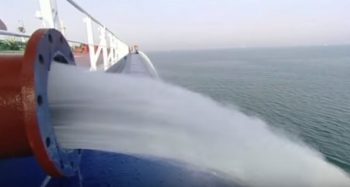
With the ratification of the Ballast Water Management Convention, shipowners are pressed to decide which treatment systems to choose. For manufacturers keen to be selected, attaining type approval by the U.S. Coast Guard can be a deciding factor. DNV GL provides comprehensive support.
After many years of discussions, the date is set. The IMO’s Ballast Water Management Convention will enter into force on 8 September 2017. For operators with vessels that discharge ballast water in international waters, this means that they must have a treatment system installed on their vessels within five years. The specific deadline depends on the next renewal survey of a vessel’s International Oil Pollution Prevention (IOPP) certificate.
For many operators trying to decide which type of system to install, one of the most important questions is: Does the system meet the U.S. Coast Guard (USCG) requirements? In late 2016, the manufacturers Alfa Laval, Optimarin and OceanSaver became the first to be awarded U.S. Coast Guard type approval certificates for their ballast water treatment systems.
“We are proud to have worked with all three of these successful applicants from the very beginning,” says Martin Olofsson, Senior Principal Engineer, Environmental Protection DNV GL – Maritime Approval of Ship Systems and Components.
In the first quarter of 2017, DNV GL submitted two further applications to the U.S. Coast Guard, for manufacturers Sunrui and Ecochlor.
“Currently, we have also completed land-based testing cycles for four further manufacturers. Successfully passing land-based testing is a good indication that the systems could also meet the U.S. Coast Guard’s requirements, once they have undergone shipboard testing,” says Olofsson. “Land-based testing really challenges the efficacy of these systems. In 15 test cycles, they expose the systems to 1,000 times more large organisms and ten times more medium-sized organisms than shipboard testing.”
If all goes to plan, another four systems could be approved in the first half of 2018.
The USCG officially appointed DNV GL as an Independent Laboratory (IL) to perform type approval testing of ballast water treatment systems (BWTS) in 2013.
“DNV GL and its associated sub-laboratories DHI Denmark, NIVA (Norway), Golden Bear Facility (USA) and DHI Singapore have been deep into the details of USCG testing for three years and have gained substantial experience in what is practical and possible to achieve in compliance with the regulation,” says Olofsson.
There are now five “Independent Laboratory” accreditations for BWTS. Out of 45 BWTS manufacturers who have signed a letter of intent for having their systems approved by the USCG, DNV GL is currently handling 25, making it the largest independent provider of laboratory services by far.
The choice of the best-suited treatment system for a particular vessel depends on a number of factors: What ship type is it? Does the vessel operate in fresh or brackish water? Does it primarily sail in cold or temperate waters? Will the system have to work in high-turbidity conditions, meaning water that contains a lot of clay, algae or silt? All these questions are very important for making the right choice. The five treatment systems, which already hold or are soon expected to hold a USCG type approval certificate include UV systems, electrolytic systems and chemical injection systems.
Source: DNV GL